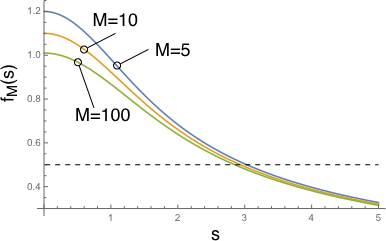the decay time in your "simple case" is well approximated by the large-$M$ limit [*]
$$\lim_{M\rightarrow\infty}M\sigma\tau=2.84$$
here is a plot of
$$f_M(s)=\left.\frac{F_M(t)}{1-F_M(\infty)}\right|_{t=s/(M\sigma)}$$
for $M=5,10,100$, that shows the half-time $s\approx 3$ is quite accurate already for not so large values of $M$
http://ilorentz.org/beenakker/MO/fMs.png
[*] for the large-$M$ limit I replace the sum in the defition of $F_M(t)$ by an integral and solve for the half-time,
$$\int_0^M\frac{2(M-x)}{M^2}e^{-(\sigma \tau x)^2}\,dx=\frac{1}{2}$$
this gives $M\sigma\tau=2.84092\cdots$.
